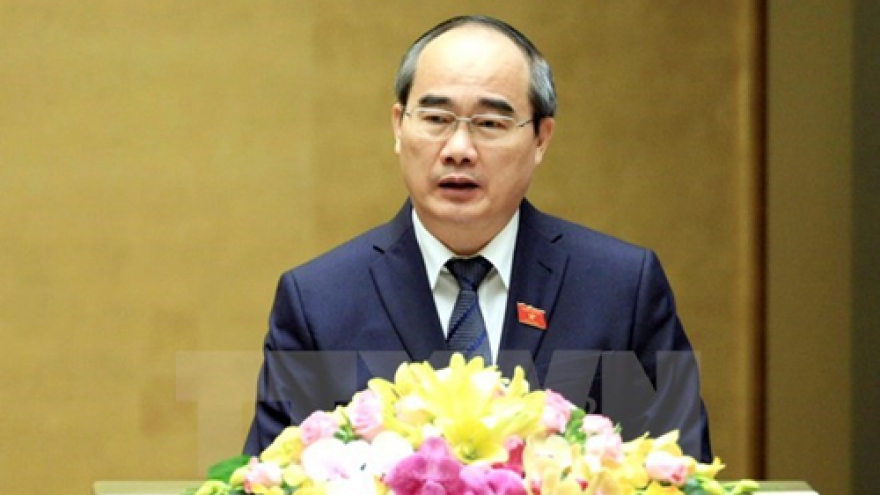PM: macro economy stabilised in nine months
The country’s macro economy was stabilised and major balances were basically ensured in the first nine months of this year, Prime Minister Nguyen Xuan Phuc said at the opening of the second session of the 14th National Assembly on October 20.
The Consumer Price Index (CPI) rose 3.14 percent in the January-September period and is expected to increase 4 percent this year, he said, adding that bad debts continued to be settled in combination with improving credit quality and ensuring the liquidity and safety of the banking system.
Credit growth reached 11.24 percent in the first nine months. Some credit organisations continued to reduce mobilising and lending interest rates by about 0.5-1.5 percent. The foreign exchange rate and the forex and gold markets were stable while foreign currency reserves hit a record of over US$40 billion.
Capital mobilisation for development investment was stepped up. In the nine-month period, the disbursement of foreign direct investment (FDI) went up 12.4 percent while around US$2.7 billion of official development assistance (ODA) and preferential loans was also disbursed. The capitalisation of the stock market reached 63 percent of the Gross Domestic Product (GDP), the highest level so far. The foreign indirect investment sharply increased. Total social investment for the whole year is estimated to reach 32.5 percent of the GDP, higher than the plan of 31.5 percent.
Investment promotion was implemented more effectively. Time for business registration was shortened to 1-3 days. In the first three quarters, more than 81,000 new enterprises were set up and over 20,000 businesses resumed operations.
These achievements have created trust and excitement among people, investors and businesses, PM Phuc commented.
He went on to say that agricultural production showed signs of recovery, with a 0.65-percent growth in the first nine months of this year.
Effortswere also given to accelerate agricultural restructuring and new-style rural area building. The national target programme on building new-style rural areas saw positive outcomes, with 27 districts and 2,061 communes meeting all new - style rural area criteria, accounting for 23 percent of the total. The respective figures are expected to increase to 30 and 2,200by the end of 2016.
The Prime Minister stated that the Government paid much attention to dealing with climate change and natural disasters, especially drought in the central and Central Highland regions, saline intrusion in the Mekong Delta region, and storms and floods in northern and central provinces.
Key measures were taken to fine-tune institutions, speed up administrative reform, fight corruption and wastefulness, as well as safeguard national sovereignty and ensure social order and security, he added.
Many master strategies were implemented effectively, contributing to promoting international integration, and maintaining socio-economic stability in the context that the country joined new-generation free trade agreements.
As many as 64 countries have recognised Vietnam’s market economy so far. The Government has completed procedures for the ratification of the Trans-Pacific Partnership Agreement (TPP).
PM Phuc stressed that the Government will continue making efforts to realise targets set for 2016 and successfully implement the socio-economic development plan in 2017.
The Cabinet aims to reach a GDP growth of 6.7 percent in 2017. The rate of poor households (in accordance with multi-dimensional poverty standards) is set to drop by 1-1.5 percent, even 4 percent in poor districts, while the unemployment rate in urban areas will be cut to less than 4 percent and the rate of skilledlabourers is hoped to range between 55-57 percent.
The Government targets 82.2 percent of the populationcovered by health insurance and hopes that 87 percent of the industrial and export processing zones will have qualified concentrated wastewater treatment systems. Meanwhile, the forest coverage is expected at 41.45 percent next year, the PM noted.
At the session, Chairman of the NA’s Committee for Economic Affairs Vu Hong Thanh delivered a report verifying the Government’s evaluation of the results of the implementation of the NA’s resolution on the socio-economic development plan for this year and the 2017 development plan.
He said most of the members of the Ethnic Affairs Council and committees of the NA agreed with the Government’s assessment.
Some of them said it is necessary to consider more thoroughly the assessment that the macro-economy is basically stable and major balances of the economy have been ensured. Meanwhile, key economic restructuring tasks, especially restructuring public investment, commercial banks and State-owned enterprises, must continue to be accelerated, he said.
Regarding the general goal and major targets for 2017, Thanh said many opinions asked for the 2017 plan to be based on the five-year development plan for 2016-2020 to calculate each target. Others suggested adding some targets on green growth (which reflects growth in association with environmental protection), the end consumption of goods and services (which reflects people’s living standards), and labour productivity increase.
Thanh said almost all members of the Economic Affairs Committee shared the view that there should not be overall targets for each year, but concrete objectives are needed to successfully reach the overall targets of the five-year period.
For the 13 main targetsproposed by the Government, it needs to report foundations to set up and the feasibility of the targets for GDP (6.7 percent), total social investment capital (31 percent of GDP), export turnover growth rate (6-7 percent) and the rate of trade deficit (about 3.5 percent of total trade revenue) so as to precisely reflect the economic situation in Vietnam, he added.
Thanh said the Government report named a number of tasks and solutions covering different fields such as economy, culture, health care, education, environment, defence, security and diplomacy. However, the Government should adhere to the NA’s resolution on the socio-economic development plan, the scheme for growth model reform, and the economic restructuring plan for 2016-2020.
It should also have an action programme to realise tasks for the five years and specify what it must do in 2017, Thanh noted.




